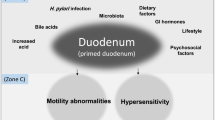Summary
AIM: Lack of understanding of the pathogenesis of functional dyspepsia is one reason for the paucity of effective treatment options. Whereas mechanical sensitivity in persons suffering from dyspepsia might be impaired, chemically induced hypersensitivity has received little attention. The aim of this study was to evaluate whether vanilloid receptors stimulated by capsaicin are hypersensitive in persons with dyspepsia. METHODS: Six volunteers with uninvestigated dyspepsia who never had consulted a physician (4 women; age, 26.2 ± 4.1 years) and six controls (3 women; age, 27.5 ± 5.9 years) underwent jejunal perfusion with capsaicin. All participants swallowed a tube with an infusion site at the ligament of Treitz and 7 cm distally a barostat balloon that was used for pressure-controlled distension. Capsaicin solution (40 μg/ml, 2.5 ml/min) was infused for 60 minutes or until discomfort was induced. Perceptions of seven different sensations were evaluated using a graded questionnaire during capsaicin infusion and jejunal distension. RESULTS: During infusion of capsaicin, the length of time until occurrence of the first sensation (P < 0.01) and discomfort (P < 0.001) was significantly shorter in those with dyspepsia than in the control group. Mechanical distension induced first sensation and discomfort at lower balloon volumes in those with dyspepsia but this difference was not significant. CONCLUSION: Jejunal sensitivity to capsaicin is increased in persons with uninvestigated dyspepsia, and vanilloid receptors might be involved in the pathophysiology of this condition. Patients with hypersensitivity to chemical stimuli may represent a distinct subpopulation based on the underlying pathophysiology and may require specific treatment to restore normal visceral sensitivity.
Zusammenfassung
ZIEL: Die Ursache der funktionellen Dyspepsie ist weitgehend unbekannt. Dies ist ein Grund für die mangelhaften Therapieoptionen, die derzeit für dieses Erkrankungsbild bekannt sind. Überempfindlichkeit gegenüber mechanischen Reizen wird als eine Ursache diskutiert, während chemische Überempfindlichkeit bisher kaum untersucht wurde. Ziel der Studie war es, zu untersuchen, ob bei Personen mit dyspeptischen Beschwerden eine Überempfindlichkeit gegenüber Capsaicin, welches Vanilloid-Rezeptoren stimuliert, besteht. METHODIK: Eine Capsaicinlösung wurde über eine oro-jejunale Sonde in das proximale Jejunum von 6 Personen mit ungeklärter Dyspepsie (4 weiblich; Alter, 26,2 ± 4,1 Jahre) und 6 gesunden Kontrollpersonen (3 weiblich; Alter, 27,5 ± 5,9 Jahre) infundiert. 7 cm distal der Infusionsstelle, die an der Flexura duodeno-jejunalis positioniert wurde, war ein Barostatballon, der zur druckkontrollierten Dehnung des Jejunums verwendet wurde. Die Capsaicinlösung (40 μg/ml, 2,5 ml/min) wurde 60 Minuten lang infundiert beziehungsweise bis heftige Beschwerden auftraten. 7 unterschiedliche Wahrnehmungsqualitäten wurden während der Capsaicininfusion und der Distension des Jejunums mittels eines Fragebogens evaluiert. ERGEBNISSE: Die Dauer der Infusion, die nötig war, um ein erstes Empfinden (p < 0,01) bzw. heftige Beschwerden (p < 0,001) auszulösen, war in der Gruppe der Personen mit Dyspepsie signifikant geringer als in der Kontrollgruppe. Empfindungsschwellen für mechanische Distension waren zwar bei Personen mit Dyspepsie geringer, dieser Unterschied erreichte jedoch das Signifikanzniveau nicht. SCHLUSSFOLGERUNG: Die Sensitivität gegenüber Capsaicin im Jejunum ist bei Patienten mit ungeklärter Dyspepsie erhöht. Vanilloid-Rezeptoren könnten somit für die Pathogenese der Dyspepsie eine Rolle spielen. Patienten mit einer Hypersensitivität gegenüber chemischen Reizen könnten wiederum von einer spezifischen Therapie, welche die chemische Sensitivität normalisiert, profitieren.
Similar content being viewed by others
Author information
Authors and Affiliations
Corresponding author
Rights and permissions
About this article
Cite this article
Hammer, J. Hyperalgesia against capsaicin in persons with uninvestigated dyspepsia: potential as a new diagnostic test. Wien Klin Wochenschr 118, 43–48 (2006). https://doi.org/10.1007/s00508-005-0474-0
Received:
Accepted:
Issue Date:
DOI: https://doi.org/10.1007/s00508-005-0474-0




